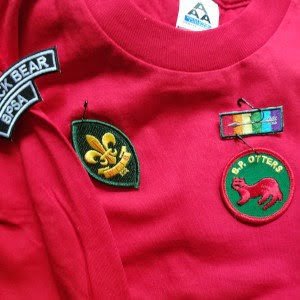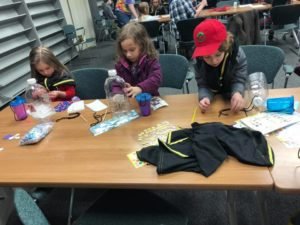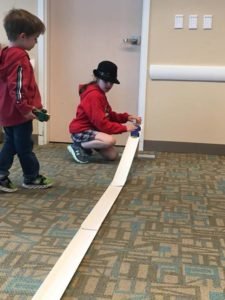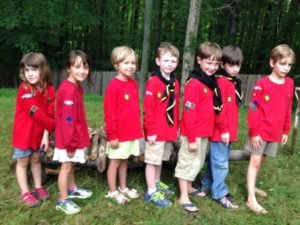What to do with Otters?
Having an Otter Raft is a lot of fun. It can also be a lot of work! The Otter level of OSG is for kids ages 5-7 and is designed to introduce them to scouting. The Otter level has a small set of badges, each with a pretty lengthy requirements list. My group, the 17th Black Bears, has established a rhythm to the Otter program, a cycle if you will. This rhythm spaces out the badges and keeps the program moving along at an even pace for our scouts.
Your group may create a different order to do your badges, but this is what is working for us.
The Otter Cycle
The Otter program naturally breaks into three phases or years. If your scout joins at age 5 and continues through age 7, they’ll be an Otter for three full years. So by cycling through the three years, each child will eventually get all the badges. Of course, not all scouts join at 5 years old. So there is some room for adapting the plan to accommodate the scouts where they are. If you have a Raft of Otters who are all 6 years old and brand new to scouting, maybe you’ll only get through Years 1 and 2. Maybe you’ll be able to fit pieces of Year 3 into the other Years as you get rolling. But, more on that later.
For our discussion, let’s all think of a “scouting year” as starting in late August and going through June to align with a traditional US school year. My group typically takes eight weeks off in the summer, from mid-June to early August, for summer vacation. We camp at least twice a year, once in the fall and again in the late spring. We meet two or three times a month for meetings and weekend activities.
Year 0 – Kicking off the year
 Did I say 3 phases? I meant three phases but every year has a mini-phase that starts off the year. The Investiture badge. Every year, we do the investiture badge even if the entire raft has scouted with us before. It only takes a few meetings at the start of the year to accomplish, and returning scouts can help teach it to new ones while reviewing it themselves. It puts us all on the same page and gets us ready for working on the Paws.
Did I say 3 phases? I meant three phases but every year has a mini-phase that starts off the year. The Investiture badge. Every year, we do the investiture badge even if the entire raft has scouted with us before. It only takes a few meetings at the start of the year to accomplish, and returning scouts can help teach it to new ones while reviewing it themselves. It puts us all on the same page and gets us ready for working on the Paws.
I order uniforms as soon as I have money from parents and usually do a ceremony to invest Otters in early October. At that ceremony, each child that is new to the group is given a uniform with the badges pinned to it in the right places (which helps parents sew them on right). Each child has to make the scout sign and say the motto at this little ceremony. We try to make it special. The Otter Resources page and leader books have examples of the ceremony you can use.
Once we are all invested, we start with the work for the Year we are focusing on. Not every meeting is necessarily directly related to a badge requirement. We generally have found some other interesting scouty things to add to the year that are not badge requirements but are still fun. For example, introducing flag folding, making scout crafts, and playing other games.
We usually do a meeting of making crafts in December. There are a lot of winter-themed ideas to choose from, and this can be a low-stress meeting (which is nice in a time of year that is typically a bit more stressful for most folks). My favorite crafts have involved kits that scouts had to string beads to make little ornaments.
I try to schedule our field trips to indoor places like the Fire Station and nursing home for the late winter or early spring. These kinds of field trips and community service projects are a great way to keep up the scouting energy during the part of the year when we have a natural lull in our hiking and camping.
Year 1 – Red Paw, Blue Paw, Safety Badge
For this year we build meetings and activities around the requirements for the Helping Badge (Red Paw), the Activity Badge (Blue Paw), and the Safety badge. We also include a visit to a local police station for the Service badge (which we work on in all three years).
We generally mix and match doing things from each of the three badges throughout the year. So we don’t award the badges until spring. Some years we do a big award ceremony, others we do minor ones as we go when we are ready to hand out badges. It is up to you which feels right. These 3 badges will not fill the whole year, necessarily, it depends on how you pace it.
 Here are some ideas of things we have done over the years to meet the requirements for these three badges in different ways.
Here are some ideas of things we have done over the years to meet the requirements for these three badges in different ways.
One year we had the Otters assemble plastic pocket knives to use when learning about knife safety. They then used them to cut up playdough.
We play a game with a ball and a compass to introduce compass directions. A scout stands in the middle of a circle and has to toss the ball in the compass direction called out by another scout. Scouts stand around them at each point.
For the Safety Badge, we had the kids each give themselves “boo-boos” with a red washable marker. Then they took turns to administer first aid on each other by putting band-aids on their marker cuts.
Your Raft’s “good turn” for the Red Paw can be whatever community service project you choose for the whole group. We usually do our good turn in the fall, and visit a nursing home or assisted living center in February, so that we have two community service projects a few months apart. Visiting a Nursing Home satisfies a requirement for the Red Paw (do a good turn) and Blue Paw (visit a senior center). We like to do that visit around Valentine’s Day. The kids hand out Valentine cards they make at a meeting the week before and perform songs or skits for the residents.
The night hike can be done on a campout, but we often night hike the trail at a local park in late October because it gets dark so early that time of year. Our normal meeting time is 7:00 PM to 8:00 PM, so hiking during our meeting counts as a night hike. This also means that if a child misses out on a camping trip, they don’t miss out on this badge requirement. Some nature centers also offer night hikes in October, so it is worth checking in your area for options.
For the Helping badge requirement, spread out through the year asking kids to do one task at home, like helping do dishes or put away their laundry. Most kids can do one task between meetings. Then the next meeting, have them talk about what they did to help around the house.
Year 2 – Tan Paw, Green Paw, Safety Badge
Yes, we repeat the Safety Badge! We award it to new scouts and review it with our returning scouts. We also visit the Fire Station for the Safety Badge. Then we make Thank You cards for the Firemen as part of the Tan Paw.
 In Year 2, we usually visit an animal shelter for a service project to go with the Green Paw. We may have the kids either make dog treats, toys, or small blankets. We also do a towel drive where parents donate old towels to take into the shelter. The kids all roll and count the towels at a meeting in addition to making things. We’ve also made cat toys and stuffed hay into toilet paper tubes for bunnies.
In Year 2, we usually visit an animal shelter for a service project to go with the Green Paw. We may have the kids either make dog treats, toys, or small blankets. We also do a towel drive where parents donate old towels to take into the shelter. The kids all roll and count the towels at a meeting in addition to making things. We’ve also made cat toys and stuffed hay into toilet paper tubes for bunnies.
A quick trip to Pinterest can yield a lot of ideas for scout crafts to go with your Tan Paw. When choosing your craft, remember you want your scouts to be successful. So choose things that are age-appropriate for your youngest scouts. Many Otters have short attention spans, so try to pick crafts without too many steps to complete.
For the “make a model” requirement for the Tan Paw, we alternate between making wooden cars and toy boats. Then we have a little competition day! We see whose car or boat goes the furthest on the track or stays the straightest on the river. This alternating works well with keeping the kids interested, and it works well in conjunction with the Timberwolf Modler badge.
Year 3 – Service Badge, Swimming Otter Badge
At this point, you may have Otters that span the age range. You’ll notice that 5-year-olds and 7-year-olds are completely different creatures in terms of skill level and attention span. So this year may be a bit more complicated. But with some planning, you can have a great year that works for all your Otters. First off, do your Year 0 and get everyone Invested or re-Invested. Lean on the older kids a bit to help set a good example for the new scouts. Have them say the Otter Law and Otter Promise for the first few meetings to demonstrate.
Next, think about if it makes sense to split into two or more Rafts. If you have the leadership and the right makeup, it may be easiest for your younger Otters to be in one Raft and your older Otters in another. If that is the case, you’ll do Year 1 again but your older Raft will step away to work on Swimming Otter requirements while your younger Raft does their Blue and Red Paw stuff. For both rafts, keep working on the Service Badge. You’ve been working on it gradually over the years. The Service Badge is a lot of field trips and big concepts, so it is best to pace it out.
 Don’t forget to plan to send the Swimming Otters to spend a few meetings with the Timberwolves as a special event. Make sure to coordinate with the Akela (Timberwolf leader) to have the Swimming Otters spend time with the Timberwolves at a meeting where they can play a game and maybe participate in a Grand Howl.
Don’t forget to plan to send the Swimming Otters to spend a few meetings with the Timberwolves as a special event. Make sure to coordinate with the Akela (Timberwolf leader) to have the Swimming Otters spend time with the Timberwolves at a meeting where they can play a game and maybe participate in a Grand Howl.
If you don’t have enough leadership or kids to make two Rafts, you can work on Swimming Otter requirements without formally separating the kids. All of the kids can listen to the story of Mowgli and share some of the skills they will need for being timberwolves. The younger kids may not pay strict attention but the older kids should be able to color while you read to them.
Many scouts age up after just 2 years, that’s fine. They should have done all 4 paws. If you have a group that is close to earning the service and swimming Otter badges, you may be able to work that in on their second year, but it is okay if you don’t. How much your group can do depends on both how often you meet, and how dedicated your scouts are. It is much easier to accomplish the Swimming Otter badge if your group already has an active Timberwolf pack you can coordinate with.
Any new scouts starting in Year 2, simply do that year first. So, you can just alternate between years 1 and 2 and not do year 3 if you don’t need it.
Otters As Part of the Group
We make a point to plan activities that all three age groups participate in together, even if it is not a badge requirement for everyone. The entire group works on two community service projects each year together. We always make some kind of crafts at our last meeting in December. Even our older scouts usually make a craft at this meeting, and it is a lower stress meeting for all of us to plan at that busy time of year. Scouts could make items to gift or something to donate if you choose.
We go on camping trips, hikes, and various outdoor adventures. The goal is to find ways to scale the activity to different ages. So our Otters only camp for one night while the Pathfinders camp for two or three. The Otters build a simple birdhouse out of empty bottles and yarn while the Timberwolves work on building wooden ones with hammers.
Need more ideas?
Always ask if any of your leaders or parents have an idea for a great Otter activity. Otters love trips to see nature centers, visit local ponds, and to just get out in nature. Berry picking and farm visits are also a lot of fun at this age. As well as bike rodeos, where scouts ride bikes and trikes together through obstacle courses and show off their safety skills as well as their ability to follow directions.
If you need more ideas for your Otters, visit the Otter Resources page!
